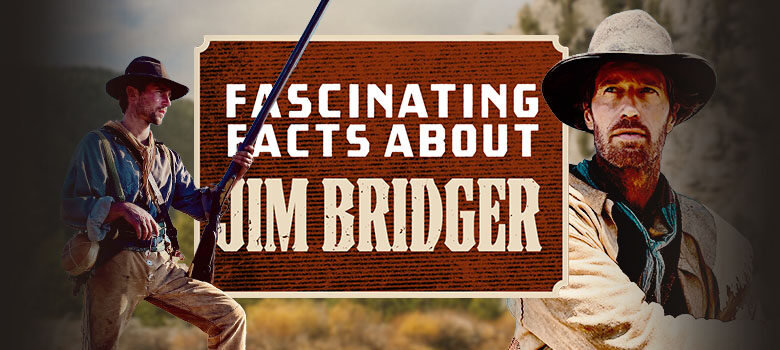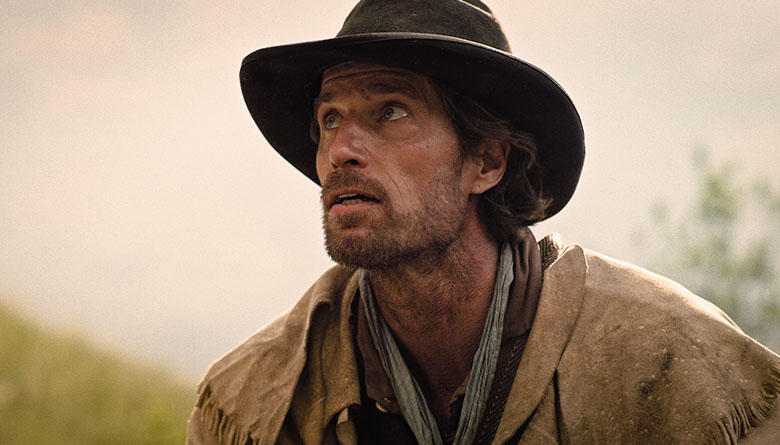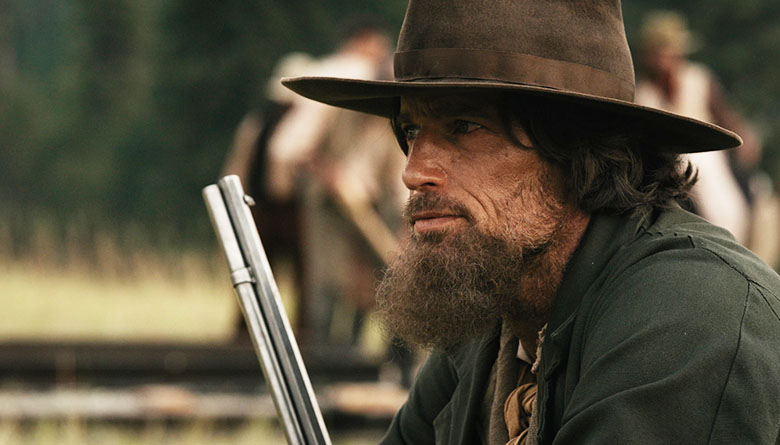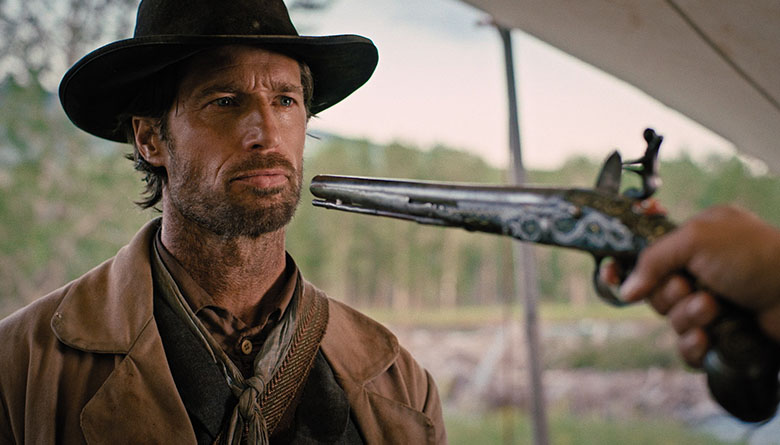Facts About Frontier Mountain Man Jim Bridger

Big, Bold, Bodacious Jim Bridger
Jim Bridger was born in Virginia in 1804, the same year Lewis and Clark ventured into the uncharted western wilderness. By 1822, Bridger would embark on his own history-making escapades as a trapper, fur trader, explorer, and army guide.
He co-founded the Rocky Mountain Fur Company and a fort bearing his name. He told stories of Yellowstone’s great geysers and churning hot springs, and he blazed a trail that shortened the route of the Oregon Trail, among his many accomplishments. Get to know this larger-than-life, teller of tall tales who paved the way west.
1. He Was a Human GPS
Jim Bridger couldn’t read or write, but he had a perfect memory of every place he’d ever set foot in the wilderness. He could draw accurate maps for settlers, fellow trappers, scientists, soldiers, prospectors, and others brave enough to attempt the perilous journey west.
2. He Was a City Slicker
Bridger was born in quaint Richmond, Virginia to parents who farmed and owned a tavern. When he was eight, his family moved west in a covered wagon to a farm in the Missouri Territory. Young Jim learned to hunt, fish, and navigate rough terrain—always on the lookout for danger, including hostile Indians.
 3. He Was Mature Beyond His Years
3. He Was Mature Beyond His Years
When Bridger was 14, both his parents and his brother died, leaving Jim to fend for himself and his younger sister. He took a job ferrying passengers across the Missouri River on a flatboat and later apprenticed with a blacksmith in St. Louis, where he heard about the need for men to hire on as trappers.
4. He Was Curious
In 1824, Bridger was on a trapping expedition with fellow mountain men along the Bear River, when he wondered where the turbulent waterway ended. He volunteered to find out. So, he built a small boat and ended up in The Great Salt Lake. Because the water tasted brackish, he believed he had made it to the Pacific Ocean. He is credited as being the first Anglo-American to witness the impressive body of water.
5. He Talked the Talk
Bridger may have been unable to read and write, but he sure had the gift of gab—in several languages, including French, Spanish, and many Native American languages and dialects.
6. He Knew How to Pivot
Though he lacked a formal education, Bridger was a savvy businessman. When he saw signs that the fur trade was on the decline, he used his vast geographical knowledge as a guide, offering his services to settlers, gold prospectors, and the U.S. Army.
 7. He Understood the Value of “Location, Location, Location!”
7. He Understood the Value of “Location, Location, Location!”
As more and more people headed west, Bridger’s skills as a trail guide were in demand, but he realized travelers had other needs on their journeys— everyday supplies, fresh horses, a blacksmith. So, he and fellow trapper, Louis Vasquez founded Fort Bridger, strategically situated in what is now southwest Wyoming, on Black’s Fork of the Green River where travelers had to pass on their way to Oregon or California. Though crudely constructed, and hardly offering the amenities of larger, established forts, Fort Bridger was a haven for trail-weary immigrants in the wilderness. It also served as a trading post for nearby Indian tribes, a respite for roving mountain men, and a place to gather, share news, information, and stories.
8. He Had a Sense of Humor
Bridger’s contemporaries described him as shrewd, honest, brave, and an exceptional guide. Beyond this, he had a way with words! If he found himself in a whole passel of trouble, he’d just as likely talk his way out of the situation as fight his way out. Most of all, he liked to laugh—and get laughs—as he shared stories of his adventures, and tall tales of his mountain man exploits. He was known to be quite the entertainer!
9. He Was Called “Old Gabe”
Bridger so impressed famous mountain man Jedediah Smith, that he said Bridger possessed the skills of the Angel Gabriel. The name stuck, and Jim Bridger became known far and wide as, “Old Gabe.”
10. He Was a Family Man
Some mountain men were recluses. Others did not want to be tied down and shied away from that little gold ring. Bridger, in contrast, was definitely the marrying kind, and like many other mountain men who chose to marry, he wed Native American women. He was a friend to many tribes and lived among the Shoshone, Crow, Flathead, Nez Perce, Ute, and others. In 1835, he married a Flathead woman, and she bore him three children. She died of a fever 11 years into their marriage. Bridger’s second wife was named Chipeta, a Ute woman. After three years together, she died in childbirth. Bridger raised the child, Virginia, on his own until she was five years old, when he sent her to live with a friend in St. Louis. Then he married Mary, the daughter of his close friend, Shoshone Chief Washakie. Of his five children, Virginia lived the longest. She was married and widowed twice. In her later years, she moved from Missouri back to the land her father explored over a century earlier. In 1933, Virginia died at age 83 in Wyoming.
 11. He Had Friends in Wild Places
11. He Had Friends in Wild Places
Surely, they didn’t know they’d become famous, but Bridger was friends, colleagues, or acquaintances with some of history’s most daring explorers and mountain men, including Kit Carson, Jim Beckwourth, Louis Vasquez, Jedediah Smith, Hugh Glass, John C. Frémont, Tom Fitzpatrick, William Sublette, Joe Meek, Andrew Henry, and William Ashley.
12. He Continues to Inspire Tall Tales and Intriguing Stories
Nearly a century and a half after his death on July 17, 1881, at the age of 77, Jim Bridger and his many adventures live on today—not only in the many western locations named for him, but also on film, TV, and in song.
- You can join him on the dangerous Bozeman Trail in INSP’s original series, Tall Tales of Jim Bridger.
- Van Heflin portrayed Bridger in Tomahawk (1951).
- Dennis Morgan played him in The Gun That Won the West (1955).
- In the Wagon Train episode, “The Jim Bridger Story,” Karl Swensonbrought the famous explorer to life.
- Reb Brown played Bridger in 1978’s hit mini-series, Centennial, with an all-star cast including Richard Chamberlain, Mark Harmon, Dennis Weaver, Brian Keith, and Sally Kellerman, among other major Hollywood names.
- Will Poulter played a version of Bridger in the hit film, The Revenant (2015)
Plus, Johnny Horton—the Country and Rockabilly musician known for the song “North to Alaska,” which was written for the John Wayne film of the same name—paid homage to the famous mountain man with his song “Jim Bridger.” The song was included on a greatest hits album, released in 1961, just a year after Horton’s tragic death in a car accident.



